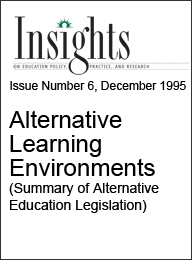References & Credits
References
- Bryant, M. (1993). America's alternative schools: Prototypes for new public schools. Paper presented at the Annual Meeting of the University Council for Educational Administration, Houston, TX. (ERIC Document Reproduction Service No. ED 363 970)
- Butchart, R. E. (1986). Dropout prevention through alternative high schools: A study of the national experience. New York: Elmira Board of Cooperative Educational Services. (ERIC Document Reproduction Service No. ED 273 872)
- Carnegie Task Force on Education of Young Adolescents. (1989). Turning points: Preparing American youth for the 21st century. Washington, D.C.: Carnegie Council on Adolescent Development, Carnegie Corporation of New York.
- Cormier, S. D., Berry, B., McCormick, C., Gredler, M. B., & Wieder, A. (1991). Assessing the impact of an alternative school for at-risk students. Paper presented at the Annual Convention of the American Psychological Association, San Francisco, CA.
- DeBlois, R. (1989). Keep at-risk students in school: Toward a curriculum for potential dropouts. NASSP Bulletin, 73, 6-12.
- Hahn, A., & Danzberger, J., with Lefkowitz, B. (1987). Dropouts in America: Enough is known for action. A report for policymakers and grantsmakers. Washington, D.C.: Institute for Educational Leadership.
- Herbst, D. P., & Sontheimer, H. G. (1987). A synergistic model for a juvenile court administered alternative education program. Journal of Offender Counseling, Services and Rehabilitation, 11, 67-77.
- Jacobs, B. (1994). Recommendations for alternative education. A Report to the Joint Select Committee to Review the Central Education Agency. (Contact person: Billy Jacobs, Texas Youth Commission, (512) 483-5000.)
- Jordan, T. S., & Jordan, K. F. (1995). State funding of programs and services for at-risk youth. Paper presented at the Southwest Educational Development Laboratory Conference on Alternative Learning Environments, Little Rock, AR.
- Kadel, S. (1994). Reengineering high schools for student success. Hot topics: Usable research. Palatka, FL: SouthEastern Regional Vision for Education. (ERIC Document Number 366 076)
- Kershaw, C. A., & Blank, M. A. (1993). Student and educator perceptions of the impact of an alternative school structure. Paper presented at the Annual Meeting of the American Educational Research Association, Atlanta, GA.
- Korn, C. V. (1991). Alternative American schools: Ideals in action. Albany, N.Y.: State University of New York Press.
- Morley, R. E. (1991). Alternative education. Dropout prevention research reports. Clemson, S.C.: National Dropout Prevention Center. (ERIC Document Reproduction Service No. 349 652)
- New Futures for Little Rock Youth. (1993). Materials and newsletters from New Futures, 209 West Capitol Avenue, Little Rock, AR 72201. (Contact person: Dorothy Nayles, Policy Analyst, (501) 374-1011.)
- Oklahoma Technical Assistance Center. (1995). Materials and results of evaluations of programs funded by the State Department of Education's Alternative Education Grant Program and High Challenge Grant Program. (Contact persons: Kathy McKean or Sylvia Oleson, (918) 225-1882.)
- Raywid, M. A. (1990). Alternative education: The definition problem. Changing Schools, 18, 4-5, 10.
- Raywid, M. A. (1994a). Focus schools: A genre to consider. New York: ERIC Clearinghouse on Urban Education, Institute for Urban and Minority Education.
- Raywid, M. A. (1994b). The research record. In J. Mintz, R. Solomon, & S. Solomon (Eds.), The Handbook of Alternative Education (pp.7-11). New York: Macmillan Publishing Company.
- Rogers, P. C. (1991). At-risk programs: Assessment issues. Center for At-Risk Students, 2, 1-4. Newsletter from the former Center for At-Risk Students housed at LaGuardia Community College, 31-10 Thomson Avenue, Long Island City, N.Y., 11101. (Contact person: Janet Lieberman, (718) 482-7200.)
- Smith, G. R., Gregory, T. B., & Pugh, R. C. (1981). Meeting student needs: Evidence for the superiority of alternative schools. Phi Delta Kappan, 62, 561-564.
- Wehlage, G., Rutter, R. A., Smith, G. A., Lesko, N. & Fernandez, R. R., (1990). Reducing the risk: Schools as communities of support. New York: The Falmer Press.
- Whalen, B. (1985). Developing an alternative high school: Dos and dont's. NASSP Bulletin, 69, 106-109.
Credits
| Insightsis published and produced by Southwest Educational Development Laboratory (SEDL). This publication is based on work sponsored by the Office of Educational Research & Improvement, U.S. Department of Education under grant number RP-91002003. The content herein does not necessarily reflect the views of the department or any other agency of the U.S. government or any other source. Available in alternative formats. The Southwest Educational Development Laboratory (SEDL) is located at 4700 Mueller Blvd., Austin, Texas 78728; 512-476-6861/800-476-6861. SEDL is an Equal Employment Opportunity/Affirmative Action Employer and is committed to affording equal employment opportunities to all individuals in all employment matters. This issue of Insightswas written by Stacey Rosenkrantz Aronson, Ph.D., Policy Associate. This publication may be reproduced and copies distributed to members by educational agencies, organizations, and associations. |

